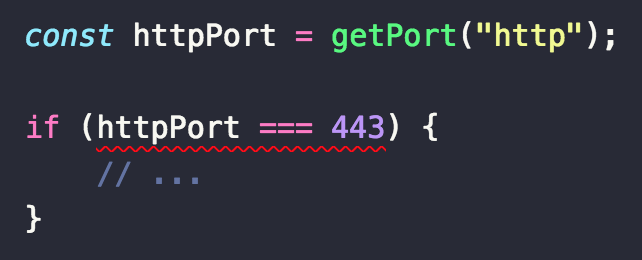TypeScript 2.0 中增加的字面量类型
Marius Schulz, “More Literal Types in TypeScript”, November 10, 2016
TypeScript 1.8 引入了 字符串字面量,将变量限制为有限的字符串集合。TypeScript 2.0 中又向类型系统中新增了下面三个字面量类型:
接下来,我们将逐个进行讲解,并搭配一些实际的案例。
布尔字面量类型
下面的例子中定义了两个常量:TRUE 和 FALSE,分别被赋值 true 和 false。
const TRUE: true = true; // OK
const FALSE: false = false; // OK=
2
尝试给每个变量赋值相反的值会导致类型错误:
const TRUE: true = false;
// Error: Type 'false' is not assignable to type 'true'
const FALSE: false = true;
// Error: Type 'true' is not assignable to type 'false'
2
3
4
5
随着布尔字面量类型的引入,预置 boolean 类型等价于联合类型 true | false:
let value: true | false; // Type boolean
While boolean literal types are rarely useful in isolation, they work great in conjunction with tagged union types and control flow based type analysis. For instance, a generic Result<T> type that either holds a value of type T or an error message of type string can be defined as follows:
布尔字面量类型很少单独使用,不过可以跟 标签联合类型 和 基于类型分析的控制流 很好的配合使用。比如,我们定义了一个范型 Reresult<T>,既支持接收类型 T 的值,也支持接收字符串类型的值作为错误信息:
type Result<T> =
| { success: true; value: T }
| { success: false; error: string };
2
3
有一个接受单参数的函数。
function parseEmailAddress(
input: string | null | undefined
): Result<string> {
// If the input is null, undefined, or the empty string
// (all of which are falsy values), we return early.
if (!input) {
return {
success: false,
error: "The email address cannot be empty."
};
}
// We're only checking that the input matches the pattern
// <something> @ <something> DOT <something>
// to keep it simple. Properly validating email addresses
// via regex is hard, so let's not even try here.
if (!/^\S[email protected]\S+\.\S+$/.test(input)) {
return {
success: false,
error: "The email address has an invalid format."
};
}
// At this point, control flow based type analysis
// has determined that the input has type string.
// Thus, we can assign input to the value property.
return {
success: true,
value: input
};
}
2
3
4
5
6
7
8
9
10
11
12
13
14
15
16
17
18
19
20
21
22
23
24
25
26
27
28
29
30
31
注意,启用 strictNullChecks 选项的时候,string 是 非空类型。为了让函数的 input 参数接受一个可为空类型的值,null 和 undefined 必须显式地包含在联合类型中。
现在调用 parseEmailFunction:
const parsed = parseEmailAddress("[email protected]");
if (parsed.success) {
parsed.value; // OK
parsed.error; // Error
} else {
parsed.value; // Error
parsed.error; // OK
}
2
3
4
5
6
7
8
9
下面是在 Visual Studio Code 编辑器中的报错信息。注意,一些属性访问因为是无效的,会标红线提示:

parsed.success 是 区别属性,所以在判断后,编译器只会允许我们访问 value 或 error 属性:
- 如果
parsed.success为true,parsed类型必然是{ success: true; value: string },所以可以访问value,但不能访问error。 - 如果
parsed.success为false,parsed类型必然是{ success: true; error: string },所以可以访问error,但不能访问value。
顺便说一下,你有没有注意到整个代码示例中唯一的 TypeScript 构件就是 Result<T> 声明和函数签名中的类型注解?其余的代码就是普通的 JavaScript。正是基于控制流的类型分析,让整块代码仍旧是完全类型化的。
数值字面量类型
类似 字符串字面量,我们可以将数值变量限制由已知值组成的有限集合:
let zeroOrOne: 0 | 1;
zeroOrOne = 0;
// OK
zeroOrOne = 1;
// OK
zeroOrOne = 2;
// Error: Type '2' is not assignable to type '0 | 1'
2
3
4
5
6
7
8
9
10
实践中,我们可以在处理端口号时使用数字字面量。不安全的 HTTP 使用端口 80,而 HTTPS 使用端口 443。我们可以编写一个 getPort 函数,并在函数签名中返回两个可能的返回值:
function getPort(scheme: "http" | "https"): 80 | 443 {
switch (scheme) {
case "http":
return 80;
case "https":
return 443;
}
}
const httpPort = getPort("http"); // Type 80 | 443
2
3
4
5
6
7
8
9
10
如果我们将字面量类型与 函数重载 结合起来会更加有趣。通过给 getPort 函数不同的重载提供更具体的类型:
function getPort(scheme: "http"): 80;
function getPort(scheme: "https"): 443;
function getPort(scheme: "http" | "https"): 80 | 443 {
switch (scheme) {
case "http":
return 80;
case "https":
return 443;
}
}
const httpPort = getPort("http"); // Type 80
const httpsPort = getPort("https"); // Type 443
2
3
4
5
6
7
8
9
10
11
12
13
现在编译器可以帮助我们检测总是为 false 的条件,例如将 httpPort 和 443 两个值进行比较:

由于 httpPort 的类型是 80,它只可能是 80,不会等于 443。这种情况下,TypeScript 编译器可以帮助你检测出有 bug 的逻辑(buggy logic)或是死代码(dead code)。
枚举字面量类型
最后,我们还可以使用枚举作为字面量类型。接着前面的示例,我们将实现一个函数,该函数将给定的端口(80 或 443)映射成对应的协议(HTTP 或 HTTPS)。为此,我们首先声明一个常量枚举类型(const enum) 来模拟两个端口号:
const enum HttpPort {
Http = 80,
Https = 443
}
2
3
4
现在,getScheme 函数同样使用函数重载进行类型注释:
function getScheme(port: HttpPort.Http): "http";
function getScheme(port: HttpPort.Https): "https";
function getScheme(port: HttpPort): "http" | "https" {
switch (port) {
case HttpPort.Http:
return "http";
case HttpPort.Https:
return "https";
}
}
const scheme = getScheme(HttpPort.Http);
// Type "http"
2
3
4
5
6
7
8
9
10
11
12
13
Constant enumerations have no runtime manifestation (unless you provide the preserveConstEnums compiler option) — that is, the constant values of the enum cases will be inlined wherever they are used. Here's the compiled JavaScript code, with comments removed:
常量枚举没有运行时表现(除非提供 PreserveConstenums 编译器选项)——也就是说,枚举里的常量值会直接替换到行内,以下就是编译出来的 JavaScript 代码(移除了注释的):
function getScheme(port) {
switch (port) {
case 80:
return "http";
case 443:
return "https";
}
}
var scheme = getScheme(80);
2
3
4
5
6
7
8
9
很简洁,不是吗?
本篇文章是 TypeScript Evolution 系列中的一篇。